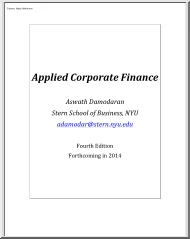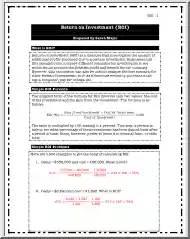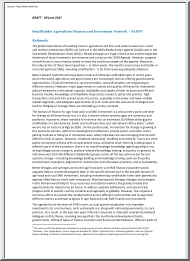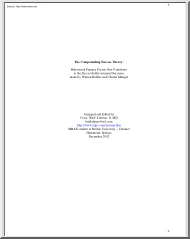Alapadatok
Év, oldalszám:2008, 6 oldal
Nyelv:angol
Letöltések száma:6
Feltöltve:2013. február 22.
Méret:79 KB
Intézmény:
-
Megjegyzés:
Csatolmány:-
Letöltés PDF-ben:Kérlek jelentkezz be!
Nincs még értékelés. Legyél Te az első!
Mit olvastak a többiek, ha ezzel végeztek?
Tartalmi kivonat
TALENT INTELLIGENCE - RETURN ON INVESTMENT SUMMARY Introduction- Risk Analysis Exercise: A detailed risk analysis exercise is conducted, as part of the Talent Intelligence Implementation Phase, to determine your current and predicted leadership risk profile. This process is repeated at least every six months The analysis process includes an understanding of the following: 1. Incumbent Retention Risk (High, Medium or Low – ie risk of the person, for whatever reason, not being position in the next 6-12 months) 2. Leadership Position (Critical Roles) Impact – Market (the impact of a critical leadership position being vacant. External focus – customers, shareholders, analysts, media) 3. Leadership Position (Critical Role) Impact – Business (the impact of a critical leadership position being vacant. Internal focus - collateral team damage, business inertia, extended period of vacancy, opportunity cost, etc) 4. Depth of Successors for each Position (# who are “Ready Now” = < 6
months) 5. Depth of Successors for each Position (# who are “Ready Later = >6 months)” 6. True Succession Depth Analysis (elimination of one person being nominated a successor for more than one position) 7. Performance & Potential Rating (team and individual) 8. “Key Must Haves” for each role – forward looking (skills, knowledge, attributes, culture fit, compensation) The resultant analysis from the above process will identify what % of the leadership team is at High Risk, High Impact and Shallow Internal Succession Depth. It is this group that is of most concern to the Board, CEO and senior HR executives! Note: The all industry average, taken from analysis of Talent Intelligence clients globally across multiple industry sectors, indicates that an average of 65% of critical leadership positions fall in to this high risk / high priority zone. It is these positions that are usually the starting point for a Talent Intelligence risk management solution. Return on
Investment: There are a number of key elements that constitute Return on Investment (ROI) from a customized Talent Intelligence solution. The ROI will vary according to the range of integrated services implemented however as a high level guide they are: 1. Top Grading 2. Completion Rate 3. Integration Success 4. Business & Competitor Intelligence 5. Enabling Technology 6. Reduced Reliance on Executive Search ROI Calculations – Summary: 1. Top Grading Top Grading, defined as hiring only the very best talent available for a given leadership position, has a significant and measurable impact on an organization’s bottom line. This is especially true when Top Grading for positions and roles that have direct revenue and net income responsibility. Being able to measure the gain in net income is a direct measure of ROI for the Talent Intelligence solution. This is based on and supported by research (Zenger and Folkman 2002) that shows that leadership ability directly affects the
performance of the organization, specifically the net income of organizations that have performance measures in place that are tied directly to revenue and profitability. There is research evidence that shows that individuals rated in the top 10% in their leadership ability were significantly more profitable, 40 – 50% more, than average leaders were in the same position. The practice of Top Grading in this summary is focused on finding the best leadership based on potential, performance, cultural fit and rating and ranking against the existing leadership team, and bench strength, at Company X. Top Grading significantly impacts the bottom line results of our clients. A critical first step to realize this impact would be to understand the key performance indicators tied to revenue and net income for each role. The KPIs, along with the implementation role analysis, will give Talent Intelligence the necessary tools to fully benchmark and profile external talent for the roles and provide
viable Top Grading options for hiring and replacement. 2. Completion Rate Completion Rate is the number of appointments that Talent Intelligence assists all of our clients with against planned or unplanned vacancies. The Talent Intelligence completion rate is 94% compared to the executive search industry standard of 67% (source Association of Executive Search Consultants 2007). The completion rate in the executive search industry has been steadily falling in the last 15 years from the high 90’s to the high 60’s. The ROI advantages of a consistently high completion rate include: l Speed – by having direct ownership and transparency of the external succession pools and talent pipelines for key roles clients are able to quickly and accurately determine the likelihood of successfully going to the external market whilst understanding the depth and breadth of the available top talent in the market. l Reduced Opportunity Cost – replacement cost is often estimated to be 2-3 times
the total annual compensation for a position and includes factors such as time taken to fill the vacancy, the cost of the vacancy to the organization (customer runoff, staff runoff, lost productivity, decision inertia, etc). Talent Intelligence has consistently demonstrated the ability to reduce opportunity costs and the time to hire by more than 50% through the combined power of speed and quality. This is achieved by having external successors and talent pipelines maintained on an on going basis against key leadership roles. 3. Integration Success Senior executives today are expected to get up to speed and deliver almost immediately. Research shows that the failure rate for executives joining from outside the organization can be as high as 1 in 2 (source RHR International 2006). With this in mind Talent Intelligence developed a proprietary research process that includes benchmark filters (“Key Must Haves”) aimed at eliminating the integration failure risk rate when bringing in
executives from the outside. This quality process. combined with our one client per industry sector account management program (deep and up to date knowledge of the client’s strategy, business and organizational needs). has ensured that Talent Intelligence maintains a 100% executive integration success rate at the twelve month tenure point. 4. Business & Competitor Intelligence There are a number of quantitative and qualitative benefits from applying the business and competitor intelligence outcomes (source Society of Competitive Intelligence Professionals) generated by Talent Intelligence to the strategic human resource function. They include: l Productivity (time savings) l Cost Reduction (decrease in errors) l Cost Avoidance (improved decision making) l Destabilizing competitors (secure top talent ahead of the competition) l Revenue increase (top grading) 5. Enabling Technology Many researchers have documented differences in bottom-line performance linked to
differences in the quality of Human Resource systems (source Gartner 2007). HR systems that are aligned to the business proposition will have a 27 percent greater return. Talent Intelligence has developed a proprietary Application Service Provider (ASP) suite of platforms that supports and aligns to the various components of our Integrated Services Model. Designed as a productivity enabler the system allows client key stakeholders, and our account teams, to manage and quickly access the intelligence being sought to address a specific problem or situation. The ROI from our customized enabling software is speed of access to accurate, relevant and timely intelligence directed against the key business and organizational imperatives of each client as well as on demand management risk reporting customized for the Board, CEO and senior HR executives. 6. Executive Search Many, if not all, of the Talent Intelligence client base have over time found that they are less reliant up on the
traditional process of Executive Search. The ROI has come from deploying the financial model associated with the Talent Intelligence solution and the resultant reduction in the direct cost of fees for executive search plus the combined ROI from high completion rates, successful executive integration and top-grading capability
months) 5. Depth of Successors for each Position (# who are “Ready Later = >6 months)” 6. True Succession Depth Analysis (elimination of one person being nominated a successor for more than one position) 7. Performance & Potential Rating (team and individual) 8. “Key Must Haves” for each role – forward looking (skills, knowledge, attributes, culture fit, compensation) The resultant analysis from the above process will identify what % of the leadership team is at High Risk, High Impact and Shallow Internal Succession Depth. It is this group that is of most concern to the Board, CEO and senior HR executives! Note: The all industry average, taken from analysis of Talent Intelligence clients globally across multiple industry sectors, indicates that an average of 65% of critical leadership positions fall in to this high risk / high priority zone. It is these positions that are usually the starting point for a Talent Intelligence risk management solution. Return on
Investment: There are a number of key elements that constitute Return on Investment (ROI) from a customized Talent Intelligence solution. The ROI will vary according to the range of integrated services implemented however as a high level guide they are: 1. Top Grading 2. Completion Rate 3. Integration Success 4. Business & Competitor Intelligence 5. Enabling Technology 6. Reduced Reliance on Executive Search ROI Calculations – Summary: 1. Top Grading Top Grading, defined as hiring only the very best talent available for a given leadership position, has a significant and measurable impact on an organization’s bottom line. This is especially true when Top Grading for positions and roles that have direct revenue and net income responsibility. Being able to measure the gain in net income is a direct measure of ROI for the Talent Intelligence solution. This is based on and supported by research (Zenger and Folkman 2002) that shows that leadership ability directly affects the
performance of the organization, specifically the net income of organizations that have performance measures in place that are tied directly to revenue and profitability. There is research evidence that shows that individuals rated in the top 10% in their leadership ability were significantly more profitable, 40 – 50% more, than average leaders were in the same position. The practice of Top Grading in this summary is focused on finding the best leadership based on potential, performance, cultural fit and rating and ranking against the existing leadership team, and bench strength, at Company X. Top Grading significantly impacts the bottom line results of our clients. A critical first step to realize this impact would be to understand the key performance indicators tied to revenue and net income for each role. The KPIs, along with the implementation role analysis, will give Talent Intelligence the necessary tools to fully benchmark and profile external talent for the roles and provide
viable Top Grading options for hiring and replacement. 2. Completion Rate Completion Rate is the number of appointments that Talent Intelligence assists all of our clients with against planned or unplanned vacancies. The Talent Intelligence completion rate is 94% compared to the executive search industry standard of 67% (source Association of Executive Search Consultants 2007). The completion rate in the executive search industry has been steadily falling in the last 15 years from the high 90’s to the high 60’s. The ROI advantages of a consistently high completion rate include: l Speed – by having direct ownership and transparency of the external succession pools and talent pipelines for key roles clients are able to quickly and accurately determine the likelihood of successfully going to the external market whilst understanding the depth and breadth of the available top talent in the market. l Reduced Opportunity Cost – replacement cost is often estimated to be 2-3 times
the total annual compensation for a position and includes factors such as time taken to fill the vacancy, the cost of the vacancy to the organization (customer runoff, staff runoff, lost productivity, decision inertia, etc). Talent Intelligence has consistently demonstrated the ability to reduce opportunity costs and the time to hire by more than 50% through the combined power of speed and quality. This is achieved by having external successors and talent pipelines maintained on an on going basis against key leadership roles. 3. Integration Success Senior executives today are expected to get up to speed and deliver almost immediately. Research shows that the failure rate for executives joining from outside the organization can be as high as 1 in 2 (source RHR International 2006). With this in mind Talent Intelligence developed a proprietary research process that includes benchmark filters (“Key Must Haves”) aimed at eliminating the integration failure risk rate when bringing in
executives from the outside. This quality process. combined with our one client per industry sector account management program (deep and up to date knowledge of the client’s strategy, business and organizational needs). has ensured that Talent Intelligence maintains a 100% executive integration success rate at the twelve month tenure point. 4. Business & Competitor Intelligence There are a number of quantitative and qualitative benefits from applying the business and competitor intelligence outcomes (source Society of Competitive Intelligence Professionals) generated by Talent Intelligence to the strategic human resource function. They include: l Productivity (time savings) l Cost Reduction (decrease in errors) l Cost Avoidance (improved decision making) l Destabilizing competitors (secure top talent ahead of the competition) l Revenue increase (top grading) 5. Enabling Technology Many researchers have documented differences in bottom-line performance linked to
differences in the quality of Human Resource systems (source Gartner 2007). HR systems that are aligned to the business proposition will have a 27 percent greater return. Talent Intelligence has developed a proprietary Application Service Provider (ASP) suite of platforms that supports and aligns to the various components of our Integrated Services Model. Designed as a productivity enabler the system allows client key stakeholders, and our account teams, to manage and quickly access the intelligence being sought to address a specific problem or situation. The ROI from our customized enabling software is speed of access to accurate, relevant and timely intelligence directed against the key business and organizational imperatives of each client as well as on demand management risk reporting customized for the Board, CEO and senior HR executives. 6. Executive Search Many, if not all, of the Talent Intelligence client base have over time found that they are less reliant up on the
traditional process of Executive Search. The ROI has come from deploying the financial model associated with the Talent Intelligence solution and the resultant reduction in the direct cost of fees for executive search plus the combined ROI from high completion rates, successful executive integration and top-grading capability




